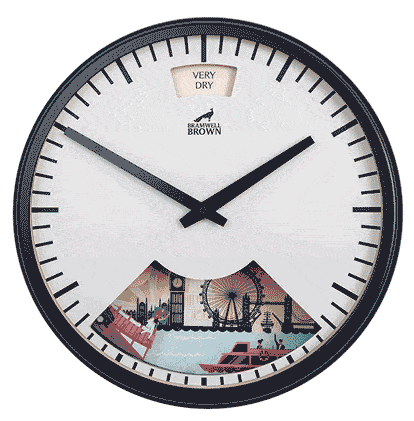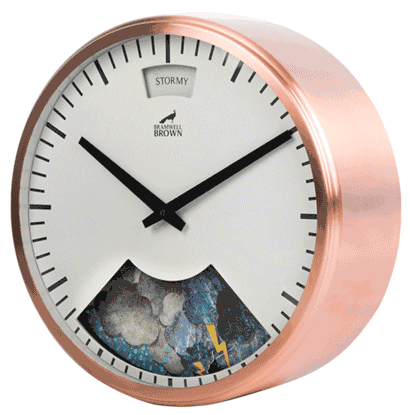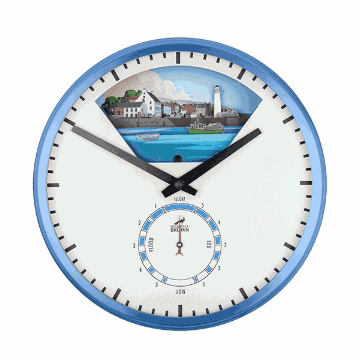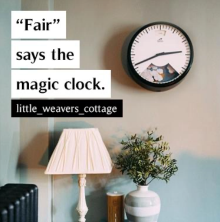The Bramwell Brown Blog
How to Choose a Wall Clock for Your Home
Whether your clock is a functional work of art or an important essential, it’s good to keep in mind the style, goals and fit when you’re thinking of adding a wall clock to a room. Wall clocks come in a wide range of patterns, materials, and designs so you’re likely to not run out of options. Think about your favourite aesthetics and start browsing with that in mind.
Consider the theme of the room
Check the wall clock material and style
Wall clock placement
What is a standard size of a wall clock?

Find the Right Location
Consider where you would glance most often to check the time. You’re not likely to be seated and looking behind you, where you would have to crane your head in weird angles. This is a fast way to get annoyed with the placement. You can stand or sit in various parts of the room and decide where you can see the clock the easiest, and where it looks good. Next to a window or door is often not the greatest spot since the bright sunlight from outside can make it hard to see.
What Size Wall Clock Do You Need
It may be helpful to take some measurements of the room that you intend to furnish with a wall clock before you make a decision to purchase one. This can give you a guide on the size range that you need to be considering. If you’re going to be hanging a clock in a smaller room, opting for a big centrepiece of a clock is likely not the best idea unless you’re intending to follow a certain theme of the room.
A smaller room generally will look good with a smaller clock, while a bigger room will do well with a larger clock. Think about size in relation to where you’re placing the clock. You may need to try a clock with a bigger face if it’s going to be looked at from a distance, like in open concept homes. In this case, the room may be small, but because the clock is visible from further away, it still needs to be readable from far.
Consider the Theme of the Room
Think about the ambiance that you want to follow throughout your room. An ultramodern room that heralds minimalist style is probably not the best place for a cuckoo clock. The two aesthetics are jarring and will throw off anyone in the room to see the mismatched styles. Instead, you could opt for something with a clean or minimal face, in the same colours and tones of your room. The clock is likely to be a muted feature of this kind of room and at this point, should not be a show-stopper.
For something more grand like a sitting room, living area or wide open space, a large ornate clock can really fit the space. With something that has a larger face and more of a presence, a clock that can match the volume of the room is often a great choice. Fitting the size of the clock to the size of the room can also make sure that you’re carrying the same ambiance throughout, as larger spaces often demand more of the decor to do the heavy lifting to aesthetically fit the space.
Recommended Reading: How to Hang a Wall Clock Without Nails
Check the Wall Clock Material and Style
With the above factors in mind, it’s time to think of the clock itself. Depending on your current themes and styles, the clock that you’re drawn to may be a choice that is more or less appropriate. A room with lots of earthy tones and wood furniture is going to do well with a wooden clock, whether it’s just the frame of the clock or the entire face. Consider the dominant hues of the room as well. It’s not necessary to put a blue clock in a blue room, but maybe to draw from the accent colours nearby. A French-inspired room with lots of blues and yellows may work best with a pale yellow, or vintage white clock. Take another look at the colour wheel and see what complementary colours could help your selection.
There are a lot of traditional and classic clocks, as well as more modern editions with minimal designs in metals or plastics. A multi-purpose clock like the Bramwell Brown Weather Clock is a wonderful choice to give you a quick read of time and weather before heading out for the day. Something unique like a faceless clock, or hands and numbers that are mounted directly to the wall is something to consider to make a space more appealing, especially if the room leans toward a more neutral aesthetic. A statement-piece clock can be the foundation upon which you start decorating your room.
Wall Clock Placement
 Image Source: @comedowntothewoods
Image Source: @comedowntothewoods
In addition to deciding what room and what wall you’d like to hang your clock, you should also consider what is around it visually and where it can rest so that it is eye-level to avoid strain. A smaller clock can share the wall with a few other things, or share the visual space with other decor or furniture but it shouldn’t be crowded where someone’s eyes wouldn’t immediately land on it when looking for the time.
For a larger clock, consider making it the dominant decor object on the wall. Smaller items may look good as accents, and to help balance the visual space, but a large clock should not have to compete with anything else for visual attention.
Keeping these thoughts in mind, it’s important to ultimately choose something that you like. If a piece resonates with you and you find yourself drawn to it, then that may be the best fit you can have. You can build and change your style to fit, adding or removing pieces to match the theme.
What is the Standard Size of a Wall Clock?
Picking out a wall clock can be tricky when you consider all the factors that influence your decision. Choosing a wall clock that adequately fits the space without overwhelming it relies on the size of the wall and the decor around it. It is one of the main decor pieces that you’ll likely have in any given room, so it’s important to consider how big it should be.
Most clock sizes range from 6 inches to 18 inches in diameter. Oversized clocks are larger than 18 inches, and are best used in big spaces or rooms where the clock is far from the viewer. Smaller clocks are usually under 12 inches in width are more suitable for smaller rooms, like a bedroom and on walls where they can share the space with other decor and artwork.
Your typical clock is medium-sized, at 13 - 18 inches, and will look best on a wall where it has room to be the focal point. Positioning it at eye level or just a bit above, while leaving plenty of space around it, will help it to not look cluttered.
Exceptions might be nontraditional clocks, such as the cuckoo clock or a clock that is not square or circular in shape. However, these clocks exist for decor as much as they do function and can have different rules when being hung on a wall. Standard-shaped and -sized clocks are popular for this reason, since they are easy to decorate with, clear to read and complement most decor.
A fantastic addition to any room: take a look at our Weather Clocks






